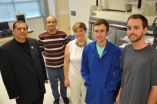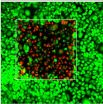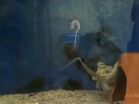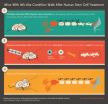(Press-News.org) Using one of the world's largest telescopes, a Lawrence Livermore team and international collaborators have tracked the orbit of a planet at least four times the size of Jupiter.
The scientists were able to identify the orbit of the exoplanet, Beta Pictoris b, which sits 63 light years from our solar system, by using the Gemini Planet Imager's (GPI) next-generation, high-contrast adaptive optics (AO) system. This approach is sometimes referred to as extreme AO.
The Gemini Planet Imager snapped an amazingly clear and bright image of the gas giant Beta Pictoris b after an exposure of just one minute.
By using a series of these images and calibrating the AO system and camera, researchers were able to refine the estimate of the planet's orbit by looking at the two discs, which are made up of gas and debris, around its parent star. They observed that the planet is not aligned with Beta Pictoris' (its star's) main debris disc but is aligned to and potentially interacting with an inner warped component disc.
"Our goal is to understand how these planetary systems have developed," said Lisa Poyneer, one of the lead Lawrence Livermore authors of a paper appearing in a recent edition of the journal, Proceedings of the National Academy of Sciences. "If Beta Pictoris b is warping the disk, that helps us see how the planet-forming disk in our own solar system might have evolved long ago."
Furthermore, the team predicts that there is a small chance that the planet will "transit," that is, partially block its star, as seen from Earth in late 2017. This would allow a very precise measurement of the planet's size. Poyneer concludes: "GPI also measures the planet's spectrum, and hence chemical composition. Knowing what it is made of and how big it is will help us figure out how it formed."
For the past decade, Lawrence Livermore has been leading a multi-institutional team in the design, engineering, building and optimization of GPI, which is used for high-contrast imaging to better study faint planets or dusty disks next to bright stars. Astronomers -- including a team at LLNL-- have made direct images of a handful of extrasolar planets by adapting astronomical cameras built for other purposes. GPI is the first fully optimized planet imager, designed from the ground up for exoplanet imaging and deployed on one of the world's biggest telescopes, the 8-meter Gemini South telescope in Chile.
Poyneer said the team is assessing how the AO system is performing and making adjustments as necessary so that it can image even more exoplanets. "The system is functioning very well and enabling new science already, but we're further improving its performance," she said.
INFORMATION:
Other Livermore scientists include Bruce Macintosh, now at Stanford University, Brian Bauman and David Palmer. The research appears in the May 12 online edition of PNAS.
Founded in 1952, Lawrence Livermore National Laboratory provides solutions to our nation's most important national security challenges through innovative science, engineering and technology. Lawrence Livermore National Laboratory is managed by Lawrence Livermore National Security, LLC for the U.S. Department of Energy's National Nuclear Security Administration.
Giant telescope tackles orbit and size of exoplanet
2014-05-15
ELSE PRESS RELEASES FROM THIS DATE:
Detailed studies reveal how key cancer-fighting protein is held in check
2014-05-15
St. Jude Children's Research Hospital scientists have mapped the structural details of how p53 attaches to its regulatory protein, called BCL-xL, in the cell. The protein p53 is a key activator of the cell's protective machinery against genetic damage, such as the mutations that drive cancer cells' explosive growth.
The detailed understanding of how these two molecular puzzle pieces fit together will help scientists design drugs that release p53 in cancer cells, triggering their suicide, called apoptosis.
The findings appear in the current online journal Nature Structural ...
Researchers examine intersection of aging, chronic disease
2014-05-15
A new collection of articles appearing in The Journals of Gerontology, Series A: Biological Sciences and Medical Sciences examine how the basic biology of aging drives chronic disease. Together, they highlight the value of the emerging field of geroscience, which uses an integrated approach to the study of diseases and disability associated with growing older.
Geroscience seeks to bridge the divide between studies of aging and studies of chronic disease, with the hope of understanding their complex relationship and pointing the way to novel interventions for disease, ...
Silly Putty material inspires better batteries
2014-05-15
RIVERSIDE, Calif. (http://www.ucr.edu) — Using a material found in Silly Putty and surgical tubing, a group of researchers at the University of California, Riverside Bourns College of Engineering have developed a new way to make lithium-ion batteries that will last three times longer between charges compared to the current industry standard.
The team created silicon dioxide (SiO2) nanotube anodes for lithium-ion batteries and found they had over three times as much energy storage capacity as the carbon-based anodes currently being used. This has significant implications ...
Going beyond the surface
2014-05-15
BUFFALO, N.Y. – Photodynamic therapy (PDT) is an effective treatment for easily accessible tumors such as oral and skin cancer.
But the procedure, which uses lasers to activate special drugs called photosensitizing agents, isn't adept at fighting cancer deep inside the body. Thankfully, that's changing due to new technology that could bring PDT into areas of the body which were previously inaccessible.
Described May 11 in the journal Nature Photonics, the approach involves using near-infrared beams of light that, upon penetrating deep into the body, are converted into ...
How octopuses don't tie themselves in knots
2014-05-15
VIDEO:
An octopus is treating its own freshly amputated arm in a strange and exploratory manner that is not commonly seen with respect to food items. Note the 'startle' response of...
Click here for more information.
An octopus's arms are covered in hundreds of suckers that will stick to just about anything, with one important exception. Those suckers generally won't grab onto the octopus itself; otherwise, the impressively flexible animals would quickly find themselves all tangled ...
First test of pluripotent stem cell therapy in monkeys is a success
2014-05-15
Researchers have shown for the first time in an animal that is more closely related to humans that it is possible to make new bone from stem-cell-like induced pluripotent stem cells (iPSCs) made from an individual animal's own skin cells. The study in monkeys reported in the Cell Press journal Cell Reports on May 15th also shows that there is some risk that those iPSCs could seed tumors, but that unfortunate outcome appears to be less likely than studies in immune-compromised mice would suggest.
"We have been able to design an animal model for testing of pluripotent ...
Mice with MS-like condition walk again after human stem cell treatment
2014-05-15
(SALT LAKE CITY) - Mice severely disabled by a condition similar to multiple sclerosis (MS) were able to walk less than two weeks following treatment with human neural stem cells. The finding, which uncovers potential new avenues for treating MS, will be published online on May 15, 2014, in the journal Stem Cell Reports.
In striking contrast to active, healthy mice, those with an MS-like condition must be fed by hand because they cannot stand long enough to eat and drink on their own. When scientists transplanted human neural stem cells into the MS mice, they expected ...
Not just a pretty face, although that helps female politicians on election day
2014-05-15
Female politicians' success can be predicted by their facial features, especially in conservative states where women with more feminine faces tend to do better at the ballot box, a Dartmouth College-led study finds.
The results don't mean a supermodel will win the White House, but they do suggest women's electoral success requires a delicate balance between voters' perception of traditional femininity and political competence. The study appears in the journal Social Psychological and Personality Science. A PDF of the study is available on request. Here is a video animation ...
Stem cell therapy shows promise for MS in mouse model
2014-05-15
LA JOLLA, CA—May 15, 2014—Mice crippled by an autoimmune disease similar to multiple sclerosis (MS) regained the ability to walk and run after a team of researchers led by scientists at The Scripps Research Institute (TSRI), University of Utah and University of California (UC), Irvine implanted human stem cells into their injured spinal cords.
Remarkably, the mice recovered even after their bodies rejected the human stem cells. "When we implanted the human cells into mice that were paralyzed, they got up and started walking a couple of weeks later, and they completely ...
Genetic tracking identifies cancer stem cells in human patients
2014-05-15
The gene mutations driving cancer have been tracked for the first time in patients back to a distinct set of cells at the root of cancer – cancer stem cells.
The international research team, led by scientists at the University of Oxford and the Karolinska Institutet in Sweden, studied a group of patients with myelodysplastic syndromes – a malignant blood condition which frequently develops into acute myeloid leukaemia.
The researchers say their findings, reported in the journal Cancer Cell, offer conclusive evidence for the existence of cancer stem cells.
The concept ...



